10 Reasons to Be Bullish on Bitcoin in 2023
2023 is shaping up to be an exciting year where the industry builds to deliver even more value for Bitcoin users and investors around the world.
Bitcoin is an industry that knows no chill. Things move fast in this world, and if you aren’t paying attention, you may just miss an important development that could impact Bitcoin for years to come.
2022 was one of the most tumultuous years in Bitcoin and the broader cryptocurrency industry yet. It was the year when Bitcoin differentiated itself from the pack. After the demise of crypto casinos and centralized copycat cryptocurrencies, it’s becoming more clear to people than ever before why Bitcoin is the true innovation, not “crypto.”
Despite this fact, Bitcoin’s price has not been immune to the challenging macroeconomic environment and the turmoil within the broader cryptocurrency industry. It has suffered a 59% decline over the last 12 months, but there are plenty of reasons to remain bullish on the future of this technology.
Swan Private Insight Update #19
This report was originally sent to Swan Private clients on January 16th, 2023. Swan Private guides corporations and high net worth individuals globally toward building generational wealth with Bitcoin.
Benefits of Swan Private include:
- Dedicated account rep accessible by text, email, and phone
- Timely market updates (like this one)
- Exclusive monthly research report (Insight) with contributors like Lyn Alden
- Invitation-only live sessions with industry experts (webinars and in-person events)
- Hold Bitcoin directly in your Traditional or Roth IRA
- Access to Swan’s trusted Bitcoin experts for Q&A
For those looking past the price and paying close attention to developments in the industry, 2022 was a year of cleansing and building in Bitcoin. It was a year where bad actors were exposed and cleared out, and where many cryptos were revealed for what they really are, nothing more than pump-and-dump schemes or outright scams.
At the same time, in Bitcoin land, institutions and entrepreneurs delivered products and continued to build the infrastructure and tools that will continue to drive Bitcoin adoption forward. We saw some new innovations emerge, and we observed the continued adoption of not only Bitcoin itself but also in its second-layer scaling solutions like the Lightning Network. On top of that, we watched as Bitcoin miners both struggled and succeeded in ways they never had before over the course of the last year.
In this piece, I will reflect on a wild year and highlight 10 reasons why investors should feel bullish about Bitcoin’s long-term outlook as we head into 2023.
This past year in Bitcoin exposed the weaknesses of centralized cryptocurrencies and crypto casinos for all to see. It began in May with the crash of the algorithmic stablecoin Terra Luna. $50 billion dollars of value was wiped out in days. From there, highly leveraged hedge funds turned Ponzi schemes like Three Arrows Capital imploded and took down many crypto lenders with them like Voyager, Celsius, and BlockFi. All of these centralized organizations were rehypothecating client funds into risky investments that blew up in their faces as the macro environment abruptly changed. This culminated in the exposure of one of the largest frauds of all time, FTX/Alameda Research.
Although the contagion is still spreading to firms like DCG/Genesis, the hard lessons learned by many from all of these events cannot be overstated. People are beginning to understand how Bitcoin is different from all of these other cryptocurrencies that are inherently less secure, have founding teams that can manipulate them, and have risks that don’t exist in Bitcoin.
Furthermore, from these collapses, market participants appear to now better appreciate the importance of self-custody. In the midst of all of this crypto carnage, we saw a fifth of all bitcoin held on exchanges withdrawn over the last 12 months alone.
Glassnode
This is an incredibly bullish outcome from this crypto contagion. The more that people take bitcoin off of exchanges into self-custody, the less concentrated the circulating supply becomes, and, thus, the more distributed Bitcoin becomes. Also, the more people self-custody, the more they are using Bitcoin in a sovereign, trustless manner, the way Bitcoin was meant to be used.
Lastly, people are starting to understand that, if they do decide to leave their bitcoin with a third party, all custodians are not created equal. It’s important to do proper due diligence to ensure that the custodian you use is not commingling or rehypothecating user funds.
If you have been following Swan closely this year, you know that our CEO, Cory Klippsten, and others have been consistently warning investors about these crypto casinos, lending platforms, and other cryptocurrencies. We consistently encourage our clients to take self-custody through education and by allowing free and automatic withdrawals into self-custody, and warn of the dangers of centralized tokens. At Swan, we are Bitcoin focused for a reason.
If our clients are not ready to take self-custody, then we believe we offer an industry-leading custody solution that protects our clients against the risks that have plagued investors who have used these other platforms. In many ways, this is the year that Swan’s thesis of Bitcoin-only, no lending products, no rehypothecation, and pushing self-custody above all else, has been vindicated. Ultimately, that many bad actors, centralized cryptocurrencies, and fraudulent operations got wiped out this year, is a positive. It has resulted in a healing, cleansing effect on the industry and was necessary in order to move forward on a more solid foundation.
This year we saw major oil and gas producers begin to get interested in Bitcoin mining due to its ability to help them make stranded energy resources productive and to help them comply with environmental regulations.
Natural gas is a by-product of oil production that often gets stranded because there are no pipelines and infrastructure in place to take it to market. Often times the natural gas is vented directly into the air or flared (burned off). In other words, the natural gas is wasted. This process is not only uneconomical for the producer, but it also is harmful to the environment.
According to the EIA, about 1.25 billion cubic feet of natural gas was vented or flared in the United States every day in 2018. That’s enough to power a large city for an entire year.
EIA
It gets worse — over the next 20 years, the EIA predicts that 5 trillion cubic feet of natural gas is likely to be flared or vented in the US alone.
This is an obvious problem without many viable solutions. Enter Bitcoin mining.
Bitcoin mining is unique because you can take the mining machines directly to the stranded energy resource. It is a profitable use of stranded energy that’s location independent and does not need to be close to humans to operate. A big problem with these stranded energy resources is there are no expensive pipelines or transportation to get the gas to market. Now you can bring the (Bitcoin) market directly to the oil well. Bitcoin miners can be co-located at the stranded energy resources themselves and function perfectly, fixing this problem.
On top of making stranded gas profitable for these producers, Bitcoin mining can also help them meet environmental regulatory requirements. The process of mining natural gas with Bitcoin miners reduces CO2-equivalent emissions by ~63% compared to regular flaring practices, according to Crusoe Energy Resources!
Bitcoin mining is helping to make stranded/wasted energy profitable, can make renewable projects that are under construction more economical, and can help producers remain regulatory-compliant by reducing their carbon footprint in the process. Bitcoin mining represents a new way to monetize gas in a way that also lowers CO2 emissions.
This is as close to a win-win as you’ll see in the business world. Oil & gas producers get all of the benefits mentioned above, and Bitcoin miners get access to extremely cheap energy considering the natural gas was going to be wasted anyways.
This year we have seen major oil & gas producers start to understand how Bitcoin mining can help improve their business:
Exxon Mobil — has been running a Bitcoin mining pilot with Crusoe Energy Systems since January 2021 to use stranded gas in North Dakota to mine Bitcoin and reduce emissions and is now considering expanding this program to other oil well sites in four countries around the globe.
This was significant because Exxon Mobil does not expand pilot programs to four countries if they do not see potential in the program. Crusoe Energy Systems was recognized by the World Bank as a new innovative application in helping in the global gas flaring reduction initiative, and Exxon Mobil will likely expand this program as they continue to evaluate technologies that help them reduce flaring volumes across their operations.
ConocoPhillips — announced that it has one Bitcoin mining pilot currently operating in the Bakken shale of North Dakota that uses natural gas to mine bitcoin and reduce its emissions, a first for the large energy company. A spokesperson for ConocoPhillips said, “ConocoPhillips has one bitcoin pilot project currently operating in the Bakken, where gas that would otherwise have been flared is routed to a bitcoin processor owned and managed by a third party,”
This is another major oil & gas producer turning to this new technology to help them make their operations more efficient and profitable while complying with environmental regulations.
Shell — announced a new Bitcoin mining initiative where it will sell lubricant and cooling solutions to Bitcoin miners, and it also signed a two-year sponsorship agreement for the Bitcoin 2022 and Bitcoin 2023 conferences in Miami.
Shell highlighted that by selling its lubricant to Bitcoin miners, it hopes to cut the energy costs and carbon footprint of Bitcoin mining by nearly 50% through “its high cooling efficiency, flow behavior, and excellent thermodynamic properties.”
Shell is one of the top five biggest oil companies in the world by revenues and profits, so their endorsement gives a lot of credibility to the Bitcoin industry moving into 2023.
2022 was the year that major oil & gas producers acknowledged the symbiotic business relationship that exists between themselves and Bitcoin miners, and I expect this trend to continue into the new year.
One big difference between the bear markets of 2018 and 2022 is that institutional investors did not stop building and bringing products to market this past year. In 2018, institutional interest in Bitcoin ground to a halt, and Goldman Sachs even shut down its Bitcoin trading desk. Back then, institutions fell out of love with the asset completely, but things played out differently in 2022.
In this bear market, we have seen the exact opposite reaction from institutions. They have continued to build and announce new products around Bitcoin, indicating that they still have long-term conviction in the value and utility of this new asset despite its recent price drawdown.
Some of the big institutional developments this year were the following:
BlackRock, the world’s largest asset manager with $10 trillion dollars under management, was busy during this bear market. First, BlackRock partnered with Coinbase Prime to offer its institutional clients of Aladdin, BlackRock’s popular investment management platform, with direct access to bitcoin.
The giant firm then announced the launch of a spot Bitcoin private trust available to its institutional clients. The firm stated, “Despite the steep downturn in the digital asset market, we are still seeing substantial interest from some institutional clients in how to efficiently and cost-effectively access these assets using our technology and product capabilities. Bitcoin is the oldest, largest, and most liquid cryptoasset, and is currently the primary subject of interest from our clients within the cryptoasset space.”
BNY Melon, the world’s oldest and largest custodian bank, with $43 trillion dollars of assets under custody, announced the launch of their digital asset platform that will allow its clients to hold and transfer bitcoin.
BNY Melon CEO, Robin Vince, said in a statement, “Touching more than 20% of the world’s investable assets, BNY Mellon has the scale to reimagine financial markets through blockchain technology and digital assets…We are excited to help drive the financial industry forward as we begin the next chapter in our innovation journey.”
This dive into Bitcoin by BNY Melon was mainly driven by overwhelming demand from their clients for an institutional-grade Bitcoin custody solution. In a recent survey BNY Melon conducted, they found that 41% of their institutional investors hold digital assets, 75% of them are either investing or actively considering investing in digital assets, and 91% are interested in investing in digital assets within the next few years!
Sign up to start saving Bitcoin
Buy automatically every day, week, or month, starting with as little as $10.
Goldman Sachs made news in 2022 when it became the first large commercial bank to perform a bitcoin-backed loan. The lending facility lent cash to a client collateralized by bitcoin in a first-of-its-kind transaction that hints at what is to come in the future.
Fidelity, one of the largest brokerages in the world handling $11.8 trillion in assets under administration, announced the launch of its retail Bitcoin trading service, Fidelity Crypto, this year, which allows their 40 million individual investors access to Bitcoin. The service allows for commission-free bitcoin trading with a 1% spread. Importantly, the service does not allow bitcoin withdrawals into self-custody, but it is a step in the right direction.
Fidelity also made news when it publicized that it would allow investors to invest in bitcoin within 401(k) retirement plans. Under the new plan, Fidelity would let savers allocate as much as 20% of their retirement funds in bitcoin.
Around 23,000 companies use Fidelity as a platform for their employee’s retirement plans, so this new offering now opens the door for these individuals to gain exposure to bitcoin in their retirement accounts.
In 2022, we saw the amount of bitcoin on the Lightning Network steadily grow, Bitcoin’s second-layer payment protocol. It was the year that Lightning proved itself as a viable scaling solution that allows peer-to-peer, cheap, and near-instant payments while simultaneously taking advantage of the security and settlement assurances of Bitcoin’s base layer.
Lightning Network adoption increased rapidly in 2022 with more and more users turning to the payment protocol to send bitcoin payments fast and cheaply.
The network’s liquidity capacity rose from 3,299 BTC to more than 4,830 BTC in 2022.
Glassnode
Even though the amount of bitcoin locked in Lightning channels continued to increase, the number of publicly visible Lightning Network nodes dropped off from their all-time highs in 2022 after increasing substantially in 2021.
Glassnode
You can see in the chart above how the decline in publicly visible Lightning Network nodes coincided with the decline in Bitcoin’s price. This drop in nodes is likely due to users running Lightning nodes losing interest in the bear market.
Lightning channels held steady throughout 2022 after dropping precipitously in October. This occurred right at the time when a user removed 320 BTC from Lightning, representing >6% of the total Bitcoin capacity on Lightning.
Glassnode
As a result of this sudden drop in Bitcoin capacity, the number of Lightning channels quickly dropped to 68,193 channels to end the year. I expect the number of Lightning channels to recover soon as Bitcoin capacity on Lightning continues to grow.
Where a ton of the growth in Lightning has occurred is in the broader Lightning Network Ecosystem itself. This rich ecosystem now consists of dozens and dozens of startups, all offering different products and services to help improve UX/UI and drive Lightning adoption forward.
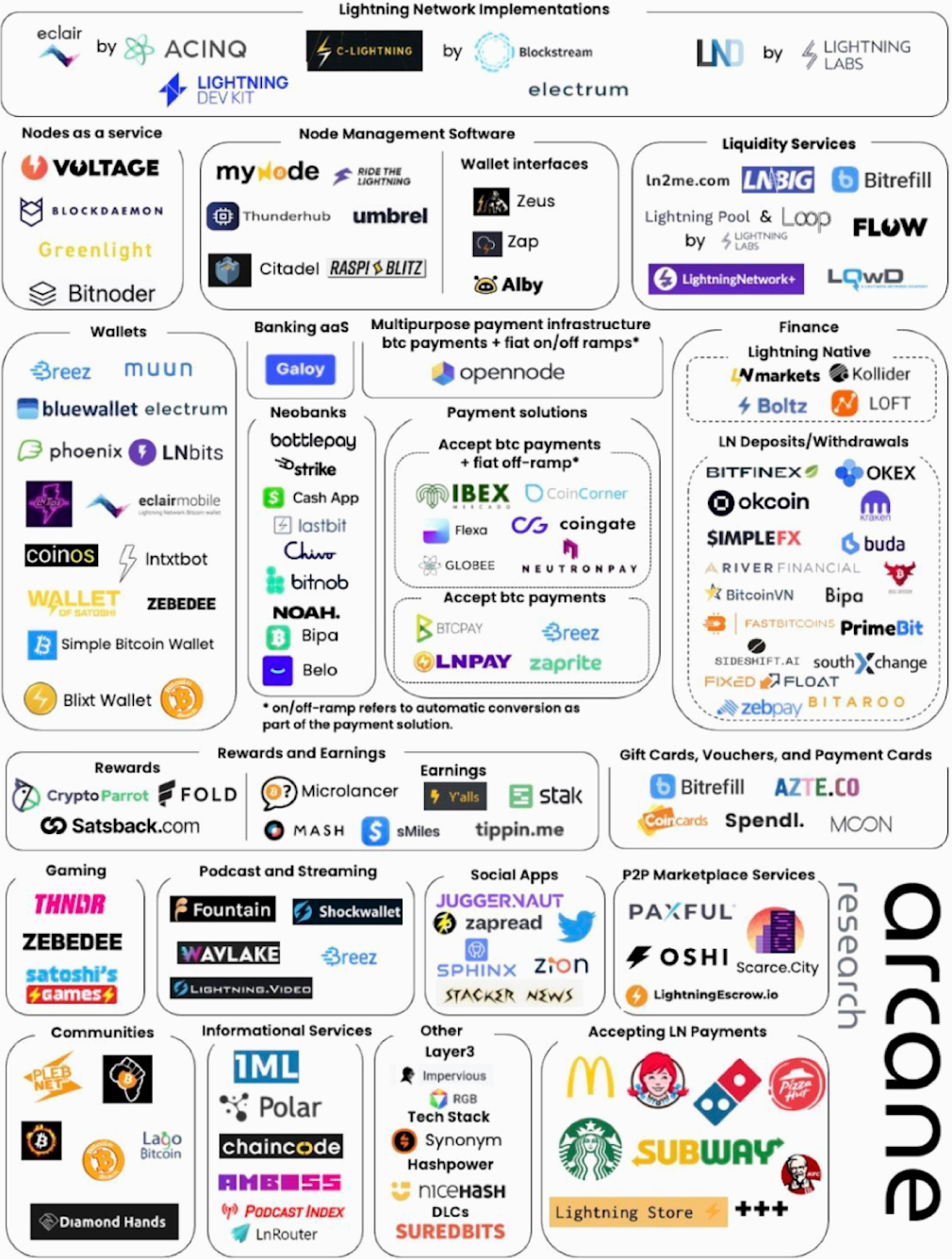
All told, the growth of the Lightning Network ecosystem was astounding this year, driven by numerous wallets that were launched, better tools for users that were built, and more educational resources that were produced. Instant, cheap payments became widespread in 2022 as Bitcoiners looked to exchange value peer-to-peer over the Lightning Network, and I expect that trend to continue into 2023.
Although Bitcoin’s base layer remained unchanging, secure, and functioned with perfect 100% uptime, there was a lot of innovation that occurred in 2022 on its second-layer scaling solution, Lightning Network, and at the application layer.
Here are five of the developments that came to light this year that got me excited:
Taro Protocol
This year, Lightning Labs introduced a protocol proposal to Bitcoin and the Lightning Network that aims to allow for the minting, sending, and receiving of assets on the networks.
Taro utilizes Bitcoin’s latest protocol upgrade, Taproot, to enable the issuance of theoretically any kind of asset on the Bitcoin blockchain while still using the immutable verification of Bitcoin’s proof-of-work consensus mechanism. Unlike previous asset issuance protocol attempts on Bitcoin, Taro is a proposal that allows for the issuing and spending of various assets whose information is transferred and stored inside of Bitcoin transactions themselves. By utilizing both Lightning and Taproot, Taro could enable asset issuance with improved efficiency, privacy, and reduced censorship risk.
A Theoretical representation of Taro within Bitcoin’s technology stack
Taro could allow for all kinds of assets like stablecoins, stocks, and bonds to be issued on top of the Bitcoin protocol opening the door for more use cases and more functionality on the network.
Fedimints
FediMint is a new promising method to custody bitcoin by forming collaborative custody communities to help secure each others’ bitcoin and protect privacy. This form of custody takes advantage of the inherent fact that people trust those closest to them the most. It leverages technologies like federations and Chaumian e-cash mints to cryptographically maintain privacy between the individuals of a group while also allowing them to share custody of the entire group’s bitcoin. Fedimints represent a middle-ground between an individual taking all the responsibility of taking self-custody of their own bitcoin and leaving it with a trusted third party, like an exchange.
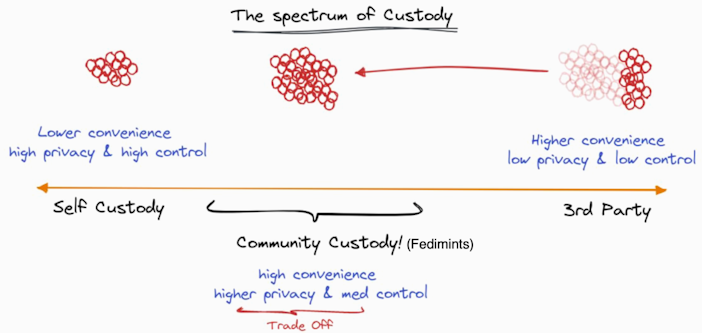
@pippellia
This community custody solution offers the possibility to scale Bitcoin, improve privacy, lower on-chain fees, and can get more individuals to take self-custody of their bitcoin around the world.
Nunchuk
Last year, Nunchuk released the first (and only) Bitcoin wallet to offer end-to-end encrypted, multi-user multi-signature capabilities.
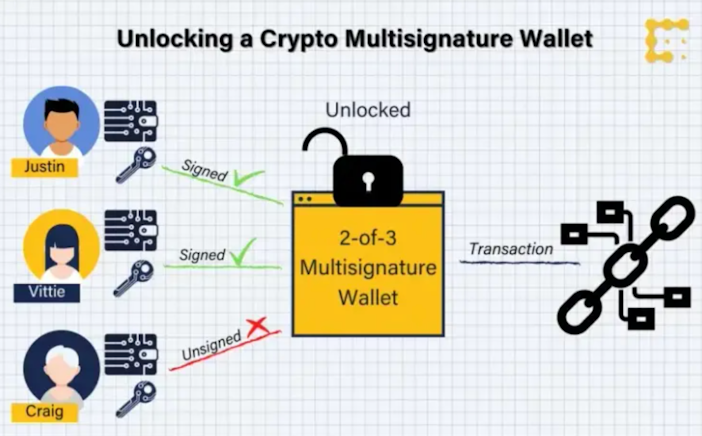
Nunchuk
This year, Nunchuk took it a step further when it announced the launch of the Honey Badger Wallet. This wallet attempts to make it easier to safely self-custody your bitcoin while also making inheritance planning easier through its time-locked 2-of-4 multi-sig feature.
The way it works is one of the keys is controlled by the platform, and another key in the multisig scheme is labeled as the “inheritance key” and is “time-locked.” By time-locked, it means that the inheritance key can only be used to claim your bitcoins on a future date chosen by the owner of the bitcoin. A beneficiary can then use the inheritance key in combination with the platform key to withdraw the inherited bitcoins.
This is another example of the innovation that’s occurring at the application level to improve UX/UI and provide solutions to problems like inheritance planning in Bitcoin.
Impervious.io
Impervious Technologies launched the first peer-to-peer (p2p) web browser built on top of Bitcoin’s second-layer scaling solution, the Lightning Network. It offers a full suite of tools for communication, data transfers, and Lightning payments without any middlemen. This comes in the form of secure p2p messaging, p2p video calls, p2p workspaces, decentralized identity management, decentralized data storage, and direct user monetization of their data.
All of these tools are fully encrypted, and they remove centralized intermediaries that collect and sell the user’s data. By utilizing the decentralized nature of the Bitcoin and Lightning Network, Impervious Technologies has given us a hint of what the Internet will look like in the future.
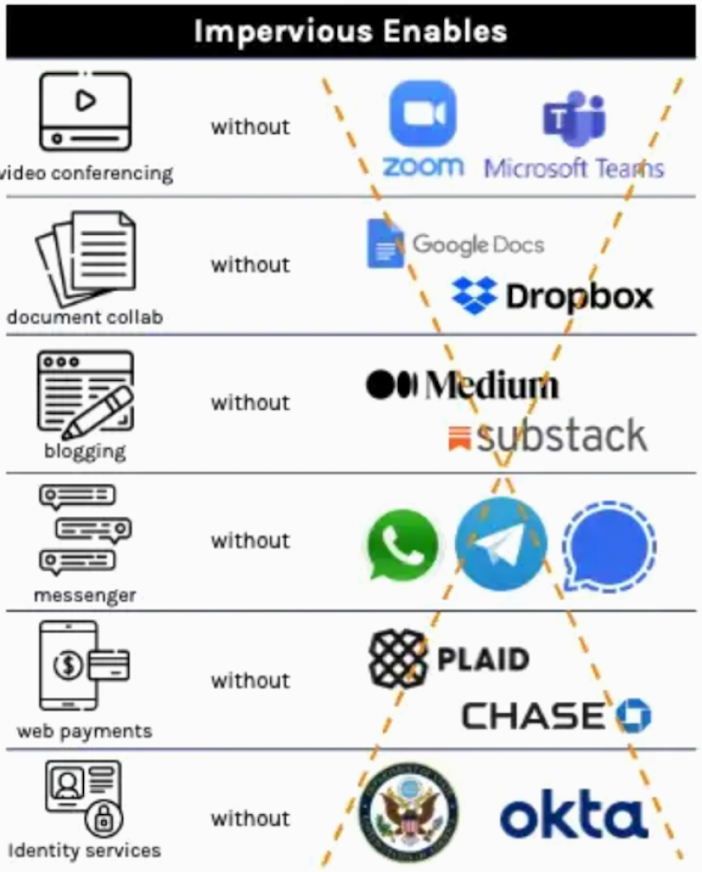
Machankura
This new service was coded by African developer, Kgothatso Ngako, who noticed a problem — most Africans have basic phones, but don’t have access to a reliable internet connection — so he created a solution. Machankura enables people in Africa to receive and spend Bitcoin via text messages without needing an internet connection.
In a report from Caribou, 94% of financial transactions in Africa are made through text messages, and only 6% of these transactions are made via mobile apps. This new service allows individuals throughout Africa to use Bitcoin for the first time on technology that is already at their disposal. Given the high inflation rates and history of capital controls throughout Africa, projects like Machankura will help push Bitcoin adoption in regions that need digital sound money the most but do not have access to smartphones or reliable internet connection.
2022 was the year that Ethereum finally changed its underlying consensus mechanism from Proof-of-Work (PoW) to Proof-of-Stake (PoS). They successfully moved Ethereum to PoS without any major network disruption, which in itself is an impressive accomplishment. Although this isn’t a specific Bitcoin development, it was still one of the most bullish events to happen for Bitcoin this year.
Allow me to explain…
Now that Ethereum has transitioned to PoS, it has left Bitcoin as the only large and functional PoW public blockchain, and it clearly draws a line in the sand between Bitcoin and Ethereum. The difference between Bitcoin and Ethereum is now clear as day.
Post-merge, Bitcoin now consumes ~99% of the total energy used by all of the functioning PoW blockchains in existence today. In other words, Bitcoin has won the energy game.
crypto51.app
Not only did the Ethereum Merge result in more mining operations mining Bitcoin than ever before, but it has also helped highlight the benefits of PoW given the absolute dumpster fire that’s been Ethereum post-Merge.
Since moving to PoS, Ethereum has objectively become more censored and more centralized. One of the reasons that Ethereum continues to become more centralized over time is the technical difficulty and high costs that are required to run a validator node. This has resulted in the rise of node-as-a-service providers, mainly consisting of large exchanges today.
Most users choose the convenience of staking their ETH with these entities, so they don’t have to deal with the headache of running a validator node themselves and risk getting penalized for making a mistake. Staking-as-a-Service has been a great bear market revenue driver for exchanges like Coinbase, Binance, and Kraken.
Another impediment to running a validator node on Ethereum for the average user is that they must deposit 32 ETH, which is too expensive for many. Lido DAO, on the other hand, is a staking service provider that allows users to bypass this requirement and earn staking rewards. Although Lido is not a single operator, the top 10 holders of LDO control >50% of the network and, thus, control what the DAO votes on. Therefore, it is better thought of as a centralized entity controlled by a small group of Lido oligarchs.
In total, 79% of ETH staking validators are controlled by 4 entities today: Kraken, Binance, Coinbase, and Lido.
Glassnode
This shows that validators are continuously becoming more centralized into these entities that need to be compliant with government and regulators to keep their doors open. This led to a risk of censorship or these entities colluding to alter the rules of the Ethereum protocol unilaterally.
It didn’t take long for this risk to become a reality on Ethereum, but it wasn’t at the staking level, but rather the relay level. Tornado Cash, a currency mixer that lets users commingle their funds to improve privacy, was sanctioned in August by the Treasury’s Office of Foreign Assets Control (OFAC), which enforces U.S. sanctions.
Since then, we have seen MEV boost relays throughout the Ethereum ecosystem censor blocks to be compliant with OFAC. This includes third-party relays and block builders like Flashbots, which are used by a vast majority of validators to increase their profits. The problem is that Flashbots and other third-party relays build blocks and decide what transactions are put in the Ethereum blocks. These are companies that need to comply with OFAC regulations. As a result, these third-party relays have been censoring transactions on Ethereum.
Since the transition to PoS, 60% of Ethereum blocks have enforced OFAC compliance. As of today, 66% of Ethereum blocks have been OFAC compliant. This has been holding steady at around 70% since early November.
MEVWatch.info
The fear is if a vast majority of blocks are running through a censoring relay like Flashbots, then realistically, it might as well be the Ethereum protocol itself that is censored. It’s important to note that an end user cannot choose which relay software an ETH validator uses at the application level. This means end users do not have the power to decide whether a validator is using a censoring or non-censoring relay or block builder. And since most Ethereum validating nodes are already centralized in four entities…you can start to see the problem here.
The issue with blocks being OFAC compliant is that every country has its own rules as to where and who individuals can do business with. The original goal of Ethereum was to be a neutral world computer that would transcend nation-states and not adhere to any one nation’s laws like OFAC, aka the U.S. Treasury.
The technology layer of the internet doesn’t adhere to any one country’s specific laws. It is an open and neutral piece of technology. Ethereum was supposed to be an apolitical smart contract protocol, but now it is essentially OFAC compliant at the base layer, with 66% of blocks now compliant with U.S. law. This is a slippery slope that can lead to more censorship down the road.
Ethereum developers’ proposed solution to this new censorship problem was to basically make a plea to Ethereum validators to “forfeit a small amount of profit in exchange for making the network more resilient.” Developers are asking validators to incur an opportunity cost and download less profitable software in order to “build open and decentralized infrastructure in line with Ethereum’s goals.”
This is an explicit admission that the economic incentives in Ethereum are broken post-Merge. If developers need to ask staking validators to voluntarily take less profit to maintain the project’s decentralization, then they have already lost.
Ethereum developers already expect they will have to make significant changes to both the Consensus and Execution clients to fix this censorship problem. What those changes will be exactly remains unclear. And so continues the story of Ethereum…with every upgrade comes new problems and more complexity, which requires more fixes, which creates more problems that need more fixes, which adds more complexity, and on and on it goes. Post-Merge Ethereum, for all intents and purposes, has been one centralized, censored mess.
As Ethereum suffers from a self-inflicted wound, Bitcoin has remained unchanged and is stronger than ever before. It has functioned exactly as it was meant to since the Genesis block, with 100% uptime for nine years straight. Where one public blockchain appears to be moving fast and breaking, Bitcoin is ticking along like a perfectly synchronized decentralized clock.
Ethereum’s move to PoS will prove to be a landmark moment for Bitcoin. One where Bitcoin’s unique traits, like its decentralization, censorship-resistance, and its immutable nature, all enabled by Proof-of-Work, will become more clear than ever before when contrasted against the ever-changing, ever-centralizing new PoS Ethereum.
In 2020, Michael Saylor made headlines when his company Microstrategy purchased hundreds of millions of dollars worth of bitcoin and put it on its balance sheet. However, he noted that there was a big problem that made it difficult for companies to put bitcoin on their balance sheets.
There are currently no accounting or disclosure rules specifically for Bitcoin. Businesses need to classify them as intangible assets, which means they have the mark the value of the asset once a year. If the price of bitcoin goes down, they have to mark the value lower on their balance sheet, and if the price goes up, they can’t record the gain unless they sell the bitcoin. This creates a huge balance sheet impairment for these companies if the price of bitcoin drops. It creates a situation where a company has to potentially list the bitcoin on its balance sheet at a lower value than the market price when it is simply holding it.
This accounting problem was clearly explained in Block’s most recent quarterly filing:
“Investment in bitcoin is subject to impairment losses if the fair value of bitcoin decreases below the carrying value during the assessed period. Impairment losses cannot be recovered for any subsequent increase in fair value until the sale of the asset. The Company recorded an impairment charge on its investment in bitcoin of $1.6 million and $37.6$ million in the three and nine months ended September 30, 2022.”
At the time of Block’s quarterly report, after purchasing $220 million in bitcoin in 2020 and 2021, the cumulative impairment charges suffered by Block to date was $108.7 million, and the fair value of their investment in bitcoin was $156 million based on the current market prices. As you can see, with the current accounting and disclosure rules, if a business decides to invest in bitcoin, the potential impairment to its balance sheet can be substantial.
The good news is that major positive developments towards fixing this accounting problem occurred in 2022. The Financial Accounting Standards Board (FASB) is preparing a new rule proposal that would improve the accounting and disclosure rules for companies that invest in Bitcoin.
In October, FASB said that fair-value accounting best captures the economics of Bitcoin and determined the method would be a requirement rather than an option for companies. In December, FASB announced a plan for new disclosure rules. These new rule changes would fix this impairment problem and would allow businesses to recognize losses and gains on their bitcoin positions at the end of every quarter, and treat digital assets as other financial assets like stocks and bonds.
FASB expects to vote on whether to propose a digital asset rule early this year, which would be followed by a proposal sometime in the first half of 2023. This is big news for companies holding bitcoin on their balance sheets. What used to be a barrier of entry for companies considering placing some bitcoin on their balance sheets, is now close to becoming a thing of the past. For public companies that are currently sitting on historically large cash balances with CPI inflation at multi-decade highs, this could open the doors for them to invest in Bitcoin.
This year has been one giant hangover for Bitcoin miners. In 2021, we saw many mining companies go public after they were making money hand-over-fist during the bull market. After enjoying the profits in 2021 and taking advantage of cheap borrowing costs to expand their operations, many public miners discovered the hard way just how ruthless the Bitcoin mining industry is. Bitcoin miners suffered greatly this year as they saw their profitability plummet due to a combination of rising electricity and input costs, increasing hash rate, and a falling bitcoin price. This deterioration in mining economics has squeezed miner profit margins dry.
As a result, we witnessed a slew of bankruptcies, M&A activity, and debt restructurings throughout the mining industry. Many of the public miners that took on too much debt in the bull market have paid the price in the bear market. This has been a source of bitcoin sell pressure as miners have been forced sellers to keep their operations running and to pay their debts.
The bright side to this bloodbath we’ve seen throughout the Bitcoin mining industry this year is that only the most efficient mining operations with the very best operators will survive this bear market. All the inefficient mining operations with high operating costs and poor balance sheets will either be wiped out, or acquired by other miners. Bitcoin mining is truly a game of survival of the fittest, and right now, the creme is being separated from the crop. By the end of this challenging period, Bitcoin’s security layer will be more efficient than ever before.
Bitcoin security is growing more efficient, but it’s also never been more secure. In the past year, Bitcoin’s hash rate has nevertheless increased by a whopping 50%!
Glassnode
This means that Bitcoin’s security has never been stronger than it is today. Today, it requires more hash than ever before for a bad actor to perform a successful 51% attack: More energy than ever before, more specialized ASIC machines than ever before, and it still takes a lot of capital and fixed investment, operating expenses, etc.
Although the increasing hash rate impacts miner profitability, this was undoubtedly a good trend to see continue in terms of the health and security of the Bitcoin network.
In 2022, we saw Bitcoin’s hash rate absolutely explode.
This was the year that Bitcoin mining began to really show its utility to power grid companies. Bitcoin mining has unique properties that allow it to be a flexible load demand, which improves grid stability. Miners can turn on/off their machines with a flip of the switch during periods of increased demand. Essentially, they have the ability to give power back to the grid in times of stress.
Mining companies such as Riot Platforms have contracts in place where the grid operators pay them to turn off their operations in order to prevent blackouts from occurring. This occurred in Texas during a recent arctic blast when 40% of Bitcoin’s hash rate dropped as miners throughout the United States turned off their machines, showcasing their ability to improve grid stability. That hash rate has now recovered as the storm passed, and miners turned back on to consume the excess load.
@lopp
This is unique to Bitcoin mining because it is very costly for other companies to turn off their operations and turn them back on. The flexibility of Bitcoin mining companies makes them a new innovation for power grid companies that will help them make the grid more stable and reliable.
ERCOT, which manages the flow of electric power to ~26 million Texans, recently released a study stating, “This report also identifies the aggregate amount of installed generation capacity for which Large Loads, such as crypto-mining facilities, are directly interconnected, and the expected peak reduction in available generation capacity attributable to these loads during hours with the highest risk of insufficient reserve capacity for the winter season.”
Duke Energy, the second-largest U.S. energy corporation, also announced this year that they are currently studying Bitcoin mining and its potential benefits to the grid. In a podcast interview, Justin Orkney, the lead rates and regulatory strategy analyst at Duke Energy, said, “Bitcoin mining appears to be that really powerful demand response technology where they can be humming at a 100% power factor, or using the same amount of electricity all day long which is called flatline, and then within a matter of minutes they can decrease their usage at kind of a pinpoint precision level and hold it for however long they want to and then bring it right back up,”
Lastly, these developments aren’t just isolated to the United States. Tokyo Electric Power Company (TEPCO) Power Grid, the largest electric power company in Japan, announced that it is using Bitcoin mining on its power grid through its wholly-owned subsidiary Agile Energy X. They stated, “We have started experiments to confirm the system behavior and the impact on the power grid when equipment is operated with a large amount of power on the scale of 1,500 kW, and have confirmed that the equipment can operate normally.”
The integration of power companies and Bitcoin mining was one of the most exciting developments in Bitcoin in 2022. Bitcoin mining is proving to be a breakthrough innovation in the energy industry. Bitcoin miners can provide a responsive, location-agnostic, and flexible load that could bring much-needed stability to power grids all around the world.
2022 was the year that Bitcoin really showcased how it is being used as a tool for freedom for individuals around the world.
Bitcoin has unique properties such as its decentralization, censorship-resistance, and its permissionless nature that allows it to help people who are attempting to protect their wealth from confiscation, censorship, and debasement.
We saw numerous examples of this as the world spiraled out of control at times throughout the year. We saw refugees using Bitcoin during the Russia/Ukraine War to escape their respective countries with some wealth, elevated rates of Bitcoin adoption in jurisdictions with high rates of debasement, and Bitcoin being used to fund peaceful protests like the Canadian Freedom Trucker Convoy after their bank accounts were frozen by their own government.
Today, an estimated 2.2 billion people live under the blight of double-digit inflation. With this rise in inflation, we should also expect a rise in capital controls and censorship as governments and central banks attempt to close off all the exits to keep their citizenry in the local currency they control. It is encouraging to see that Bitcoin adoption continues to increase the most in jurisdictions with more political instability, higher rates of currency debasement, and increased censorship.
A highlight of this year was when 20 human rights leaders wrote a letter to Congress over the summer on the global importance of Bitcoin as a tool for freedom as U.S. regulators consider new legislation.
Here are some excerpts from the letter:
“To most in the West, the horrors of monetary colonialism, misogynist financial policy, frozen bank accounts, exploitative remittance companies, and an inability to connect to the global economy might be distant ideas. To most of us and our communities — and to the majority of people worldwide — they are daily realities. If there were ‘far better solutions already in use’ to overcome these challenges, we would know.”
“Ample evidence suggests that Bitcoin has and will continue to empower Americans and global citizens in the coming decade, and that—alongside stablecoins—this open and decentralized monetary network will help defy tyranny and strengthen democratic movements abroad.”
“To claim that the practical value and future potential of cryptocurrencies ‘does not exist’ denies the lived experience of millions of people like us and our colleagues who have depended on Bitcoin and stablecoins in times of crisis and autocracy.”
This past year, we have seen Bitcoin being used by those who need it most when everything else has failed them. More and more individuals are beginning to understand that Bitcoin has a unique ability to enforce human rights all around the world. As governments and central banks continue to debase their currencies and censorship and capital controls increase, more people will turn to a permissionless, censorship-resistant, and decentralized monetary protocol to protect their wealth and send value peer-to-peer without any intermediary.
As you can see, there were a lot of bullish developments that occurred in 2022 that have us bullish heading into the new year.
Bitcoin investors have overcome many challenges this year as Ponzi schemes exploded around them, miner bankruptcies caused forced bitcoin selling, and the Federal Reserve spiked interest rates, causing downward price action in risk assets, including Bitcoin. But despite all of this, Bitcoin hodlers have continued to hold throughout the tumultuous year. The percentage of Bitcoin circulating supply held by long-term holders (>6 months) is sitting at 72%, an all-time high. A majority of Bitcoin’s investor base remains unfazed by the recent price action.
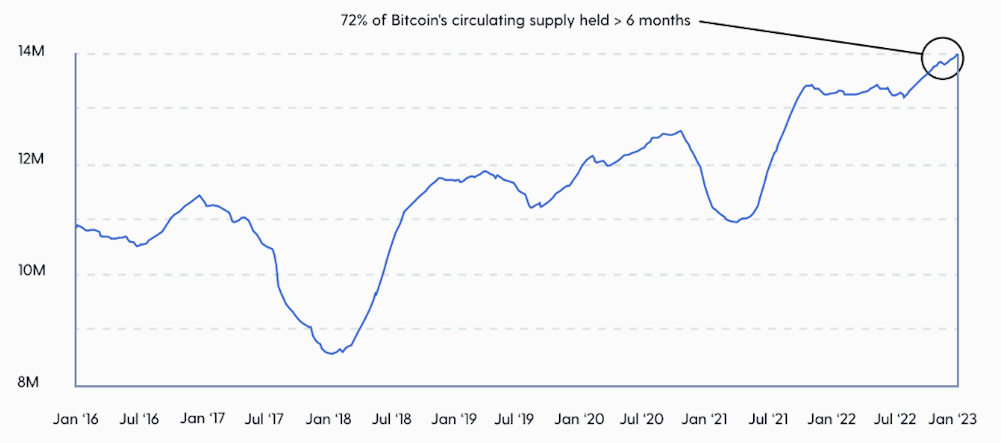
Glassnode
2023 is the Chinese Year of the Rabbit. This is fitting because I expect that more people than ever before will fall down the Bitcoin rabbit hole this year and begin learning about this new technology, given the quantity and quality of free educational resources available today. As a result of this and the broader macroeconomic environment, I expect Bitcoin adoption to continue to increase, as measured by the number of addresses holding >$100, as demand for a digital sound money that can’t be censored grows.
I expect that there will be regulatory backlash through more enforcement actions throughout the broader cryptocurrency industry in response to the FTX/Alameda Research fraud, but there will probably not be any major digital asset legislation passed in 2023. These enforcement actions are already well underway, with recent actions against the founder of LBRY, the founder of NFT Mutant Ape Planet, Gemini/Genesis getting sued by the SEC for violating investor protection laws, and Coinbase just agreeing to pay a $50 million fine for violating AML laws. The good news is that the only thing these regulators seem to be able to agree upon is that Bitcoin is a commodity. Whereas the legal status of all other cryptocurrencies — which look a whole lot like unregistered securities — remains uncertain, Bitcoin’s regulatory status is clear.
I also expect the price to continue to chop around these levels throughout 2023. We could see Bitcoin’s price retest the lows if the macroeconomic picture deteriorates, but I believe that we are currently carving out a bottom. When taking into account the macroeconomic environment of tightening monetary policy and slowing growth, I assign the highest probability to a more drawn-out bear market similar to that of 2013-2015. Given that Bitcoin has dropped 76% from its all-time high, many miners have capitulated, bad actors have been wiped out, and speculators are mostly gone, looking back, I think this coming year will be viewed as a wonderful time for investors to accumulate and build long-term positions. This would coincide with previous bear markets, which saw periods of accumulation in the year prior to each halving event (2015, 2019), as shown in the chart below.
@therationalroot
I predict we will continue to see consolidation in the mining industry as more mining companies merge or are acquired. I am anticipating more miner bankruptcies until the mining economics begin to improve. I expect Bitcoin’s hash rate growth will slow because the mining operations that are still functioning are too cash-strapped to expand their operations in any meaningful way.
Lastly, I predict in the coming year that the Bitcoin base layer will continue to function just as Satoshi intended back in 2009. There will be no big change to the consensus mechanism, and it will continue to run with 100% uptime. This simple, but profound, fact will continue to help differentiate Bitcoin from the rest of the cryptocurrency industry. I expect the innovation to continue to accelerate at Bitcoin’s scaling and application layers as new wallets and tools come to market, adding new functionalities to the decentralized Bitcoin technology stack.
2022 is when the builders and educators put their heads down and stayed laser-focused on the mission of driving Bitcoin adoption. 2023 is shaping up to be an exciting year where the industry builds off those efforts to deliver even more value for Bitcoin users and investors around the world.
Sign up to start saving Bitcoin
Buy automatically every day, week, or month, starting with as little as $10.
Sam Callahan is the Lead Analyst at Swan Bitcoin. He graduated from Indiana University with degrees in Biology and Physics before turning his attention towards the markets. He writes the popular “Running the Numbers” section in the monthly Swan Private Insight Report. Sam’s analysis is frequently shared across social media, and he’s been a guest on popular podcasts such as The Investor’s Podcast and the Stephan Livera Podcast.
More from Swan Signal Blog
Thoughts on Bitcoin from the Swan team and friends.


GBTC was the Genesis of the Crypto Credit Contagion
By Sam Callahan
Learn how GBTC works, how it’s associated with the recent crypto contagion, and why buying spot Bitcoin and taking self-custody helps you avoid all of these risks today.


The FTX Fiasco and the Fallout to Come
By Sam Callahan
Expect the fires from FTX to continue to burn and claim more victims along the way. If anything, this event has provided a tough lesson on why Bitcoin is different and why self-custody is vital.


A Look At the Lightning Network

By Lyn Alden
Examining the scaling method of the Bitcoin network and its evolution from a store of value to a medium of exchange.
